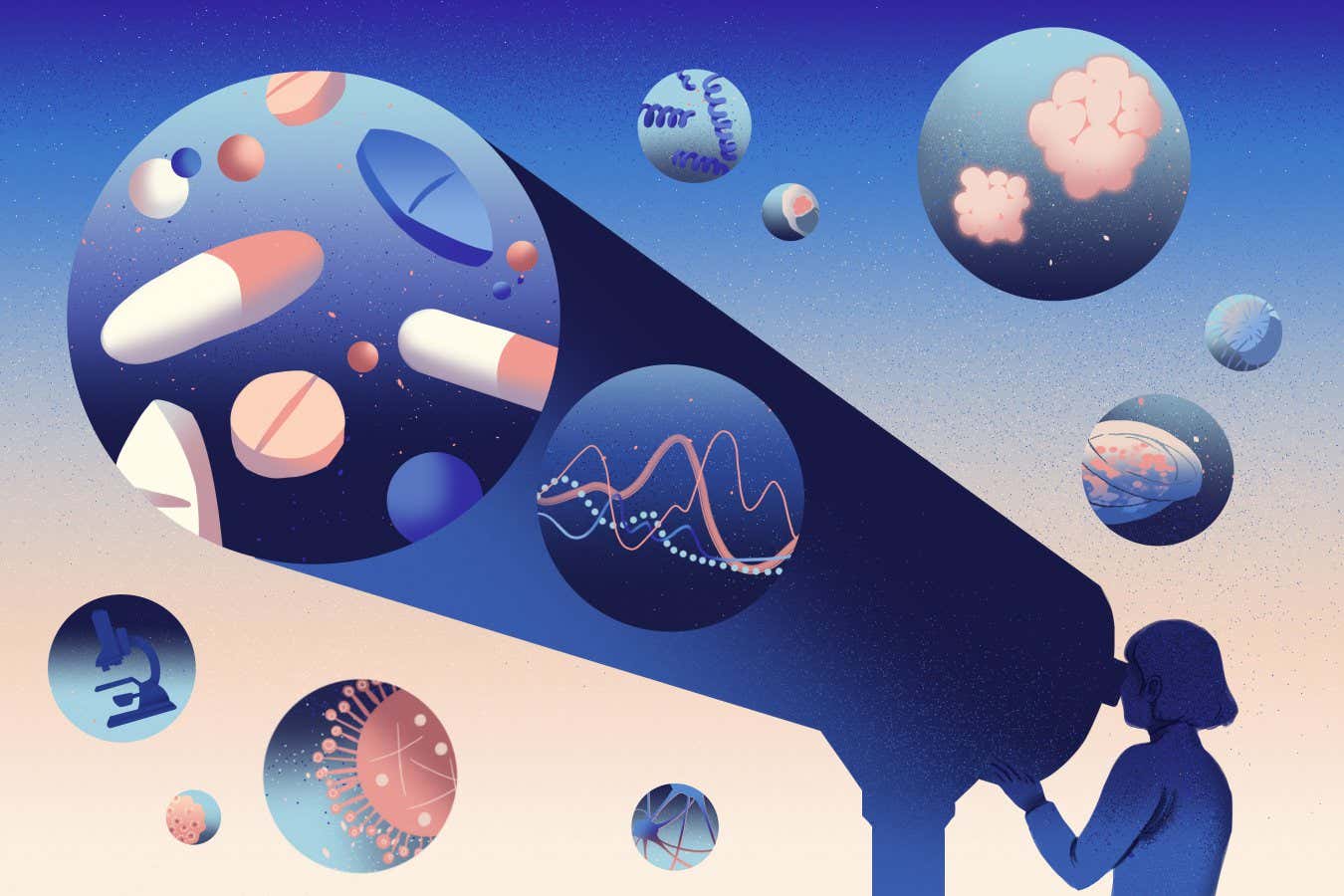

There are many symptoms of perimenopause, but the same signs could point towards different conditions altogether
Christina S. Zhu
Like many women in midlife, Stephanie had a lot going on. The 47-year-old, who lives in California, was caring for her ailing grandmother and working long hours in a physically demanding agricultural job. When her periods began getting longer and heavier in her mid-40s, she chalked it up to perimenopause. Stephanie had read articles online and knew that heavier periods were one of the dozens of symptoms of the time leading up to menopause.
Aches and pains and a growing belly were all signs of this time of life, she heard over and over again. She tried to lose weight: “I was eating 1400 calories a day and working hard and I couldn’t lose my perimenopause belly, it just wouldn’t go away. But everything I read said these things were normal.” Stephanie attended a telemedicine appointment and the doctor suggested she try a low dose of oestrogen, the standard treatment for perimenopause symptoms.
But her periods got even heavier and longer. She was exhausted and plagued by pain in her hips and back. “I was like, I guess this is ageing!” she says. “I’m a pretty tough person, so I thought, this is just what you’re handed.”
More than a year after her symptoms first started, when she was bleeding for two weeks straight every cycle, she finally saw a doctor in person. “I’d actually gone in to ask about an IUD, because I thought, ‘It’s perimenopause, there will be hormones in it that might help mitigate the bleeding’,” she says. Her doctor immediately suspected something serious. Stephanie was admitted to surgery the same day for the removal of a 7-kilogram fibroid that was attached to her uterus.
The perimenopause tidal wave
Stephanie was far from the only one swept up in the tidal wave of perimenopause content now flooding social media, podcasts and wellness marketing. The subject’s long-overdue arrival in the public square has been a relief for many, helping limit the amount of silent suffering through hot flushes, irregular cycles or insomnia. But the wave of information comes from sources of variable quality. Meanwhile, talk show host Oprah Winfrey has made a special about it; actors Naomi Watts and Halle Berry shared their stories; author Miranda July’s latest book was described as “the first great perimenopause novel”; and Gwyneth Paltrow’s Goop website has a dozen articles examining it from all sides.
Perimenopause research is now being prioritised by some governments. Australia and Canada have developed programmes to help promote perimenopause healthcare, as has the UK. This attention should help to fill in “the pervasive gaps in perimenopause research and treatment”, according to Tara Iyer, medical director of the Menopause and Midlife Clinic at the Brigham and Women’s Hospital in Massachusetts.
While this increased attention, education and research is a boon for women’s health, there is a risk that those experiencing symptoms end up assuming that any midlife health condition is a sign of perimenopause. All the healthcare providers interviewed for this article say they have seen a growing number of people arriving at appointments convinced they have entered perimenopause – but sometimes their clinical picture suggests something else entirely.

Autoimmune conditions like lupus can be mistaken for perimenopause
ZIAD M. EL-ZAATARI/SCIENCE PHOTO LIBRARY
When everything might be a symptom
“Most textbooks will list 30 to 35 recognisable perimenopause symptoms, but there are probably 60 or 70 symptoms that could be related to the hormonal changes of this transition – maybe more,” says Iyer. “Of that huge list, very few of them are going to be solely related to the hormonal changes of perimenopause.”
Classic hallmarks – hot flushes, night sweats, vaginal dryness and midlife changes in menstrual bleeding patterns – are highly likely to be hormonally driven. But most other symptoms commonly cited online, from sleep problems and joint pain to mood changes, may have multiple contributing factors.
That’s the challenge: fatigue might be due to fluctuating oestrogen levels, but it could just as easily be caused by an underactive thyroid, iron-deficiency anaemia, depression or autoimmune conditions like lupus. Brain fog might signal perimenopause, but could be the result of a vitamin B12 deficiency or sleep apnoea, or be an early sign of neurological issues. “Pain with intercourse can be due to perimenopause, but it also can be other conditions like sexually transmitted infections or some specific skin conditions like sclerosis,” says Mary Parman, who has practised obstetrics and gynaecology for 20 years in Silicon Valley, California.
“
Brain fog might signal perimenopause, but could be the result of a vitamin B12 deficiency
“
Symptoms of chronic stress can also mimic those of perimenopause. In midlife, many people are part of the pressurised “sandwich generation” – caring for ageing parents, navigating the challenges of growing kids and being at the peak of their careers – and women tend to care for everyone else before themselves, says Iyer. “We know stress, for example, is a trigger for hot flashes and night sweats. Stress can make it difficult to maintain healthy lifestyle behaviours, which can lead to mood disturbances, depressive symptoms, anxiety symptoms, irritability and weight gain,” she says.
Even changes in bleeding, supposedly a textbook sign of perimenopause, aren’t always hormonal, as Stephanie found out – hers were caused by the large fibroid. Other reproductive issues like polyps, blood-clotting conditions and endometrial hyperplasia, in which the lining of the uterus becomes thickened, can cause similar symptoms and require different treatment than perimenopause does.
Long covid is another condition that can be confused for perimenopause. The illness’s broad set of symptoms, including brain fog, disrupted sleep, palpitations, anxiety, muscle aches and fluctuations in body temperature, closely mimic and overlap with those of perimenopause. And, of course, someone could be dealing with both the effects of perimenopause and long covid or other health issues at the same time, leading to a possible exacerbation of symptoms. That is why seeing a healthcare provider in person is so important, says Parman. “That exam entails feeling the uterus and ovaries, looking for any cervical vaginal lesions, getting a pap smear done if they haven’t had one, STD testing if that’s indicated, and then they might need to get a pelvic ultrasound as well.”
In some cases, women are skipping these important in-person evaluations entirely, going straight to telemedicine providers and requesting hormone replacement therapies (HRT) for their health issues. Others are self-diagnosing and self-treating with over-the-counter supplements or hormone treatments sourced online. Parman says if symptoms are bothering you, seeing a doctor in person is important: “Let’s not miss anything assuming it’s perimenopause.”
Sorting symptoms
So how do clinicians tell the difference between perimenopause and something else? Iyer says there is no single, definitive test. “The tests we run are going to be specific to the symptoms,” she says. Someone with fatigue could be checked for anaemia or thyroid problems; someone with urinary symptoms would need STI tests or to have their urine analysed. Other possibilities include blood tests to assess basics like iron levels, white blood cell count and liver and kidney function, depending on the individual’s symptoms. There is no specific test just for perimenopause.
Outside of test results, the next most important piece of information comes from the individual themselves, says Iyer, in the form of a review of symptom patterns over time. This powerful tool requires tracking of the menstrual cycle and symptoms.
Timing can offer important clues. If symptoms cluster at predictable points in the cycle – for example, the week before menstruation – they are more likely to have a hormonal component, says Iyer. If they occur randomly, with no correlation to cycle phase, hormones may be less central to the problem.
Doctors may also use what is called therapeutic diagnosis: prescribing a short course of HRT to see if symptoms improve. “If the hot flashes, night sweats and mood changes ease up significantly, that suggests a hormonal contribution,” says Iyer. “But if some symptoms improve and others don’t, it’s a sign there’s more going on.”
For example, someone might start HRT and find their night sweats vanish, but their crushing fatigue persists. That is a signal to their doctor that they should investigate other causes.

The stress of middle-age, where women often have to care for both children and aging parents, can come with a host of health issues
Credit: Cultura/Alamy
Hormone testing could be another way to determine whether fluctuations in oestrogen or progesterone are adversely affecting someone’s health, but doctors have varying opinions on how useful it is to look directly at these shifting levels. These checks can be done via blood tests that measure levels of various hormones at a single point in time. But they are limited by being both inconvenient and expensive. “Doing a week of blood tests every day is pretty inaccessible, right?” says Amy Divaraniya, a data scientist who pivoted to women’s healthcare after being diagnosed with polycystic ovary syndrome. Now, she is the CEO and founder of Oova, a tech start-up that offers at-home hormone testing.
The technology behind Oova and several other companies, including hormone-testing firm Mira, offers a different approach: testing urine once daily at home for weeks or months, then feeding that data into an app. The information logged over time creates a more detailed picture of hormones, revealing personal patterns as they shift throughout a cycle. Divaraniya says that more than 450 clinics in the US, plus more in the UK and Australia, are using her company’s system for thousands of patients.
Iyer, though, warns against viewing home hormone testing as essential. “In many cases, we can figure this out through symptom tracking and clinical history,” she says. “I wouldn’t tell a patient to spend hundreds of dollars on testing when keeping a detailed symptom diary might be just as informative.” She also questions if the tests are accurate enough for clinical use, saying that results can be influenced by hydration, the timing of tests or the specific technology used.
Still, in certain complex cases – such as someone with irregular cycles that make symptom tracking difficult – multi-month hormone data can help rule conditions in or out.
Getting it right
Mislabeling non-hormonal symptoms as perimenopause isn’t just a diagnostic inconvenience – it can delay effective treatment and allow other conditions to worsen. Someone with an untreated underactive thyroid could develop heart disease and nerve damage. An undiagnosed autoimmune condition could cause progressive joint damage. Long covid symptoms could be exacerbated by inappropriate treatment or a lack of rehabilitation support.
“
I got all this energy back as soon as my iron levels rebounded
“
For Stephanie, getting her fibroid removed improved her health as soon as she recovered from her laparoscopic surgery. “I got all this energy back as soon as my iron levels rebounded,” she says. “I got my life back.”
The overdue attention on perimenopause is valuable, but while midlife hormonal shifts are real and impactful, they aren’t the explanation for every symptom.
The true challenge, for both those affected and their doctors, is resisting the cultural momentum that makes perimenopause the default answer. Instead, the goal should be what women’s health advocates have called for all along: thorough evaluation, careful differential diagnosis and treatment plans tailored to each person’s biology, not just their birth date.
Starre Vartan is the author of The Stronger Sex: What science tells us about the power of the female body.
Topics:



